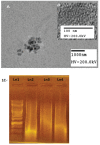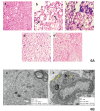Nanopharmaceutical Approach for Enhanced Anti-cancer Activity of Betulinic Acid in Lung-cancer Treatment via Activation of PARP: Interaction with DNA as a Target: -Anti-cancer Potential of Nano-betulinic Acid in Lung Cancer
- PMID: 27280048
- PMCID: PMC4887750
- DOI: 10.3831/KPI.2016.19.005
Nanopharmaceutical Approach for Enhanced Anti-cancer Activity of Betulinic Acid in Lung-cancer Treatment via Activation of PARP: Interaction with DNA as a Target: -Anti-cancer Potential of Nano-betulinic Acid in Lung Cancer
Abstract
Objectives: This study examined the relative efficacies of a derivative of betulinic acid (dBA) and its poly (lactide- co-glycolide) (PLGA) nano-encapsulated form in A549 lung cancer cells in vivo and in co-mutagen [sodium arsenite (SA) + benzo]undefined[a]pyrene (BaP)]-induced lung cancer in mice in vivo.
Methods: dBA was loaded with PLGA nanoparticles by using the standard solvent displacement method. The sizes and morphologies of nano-dBA (NdBA) were determined by using transmission electron microscopy (TEM), and their intracellular localization was verified by using confocal microscopy. The binding and interaction of NdBA with calf thymus deoxyribonucleic acid (CT-DNA) as a target were analyzed by using conventional circular dichroism (CD) and melting temperature (Tm) profile data. Apoptotic signalling cascades in vitro and in vivo were studied by using an enzyme-linked immunosorbent assay (ELISA); the ability of NdBA to cross the blood-brain barrier (BBB) was also examined. The stage of cell cycle arrest was confirmed by using a fluorescence-activated cell-sorting (FACS) data analysis.
Results: The average size of the nanoparticles was ~ 110 nm. Confocal microscopy images confirmed the presence of NdBA in the cellular cytoplasm. The bio-physical properties of dBA and NdBA ascertained from the CD and the Tm profiles revealed that NdBA had greater interaction with the target DNA than dBA did. Both dBA and NdBA arrested cell proliferation at G0/G1, NdBA showing the greater effect. NdBA also induced a greater degree of cytotoxicity in A549 cells, but it had an insignificant cytotoxic effect in normal L6 cells. The results of flow cytometric, cytogenetial and histopathological studies in mice revealed that NdBA caused less nuclear condensation and DNA damage than dBA did. TEM images showed the presence of NdBA in brain samples of NdBA fed mice, indicating its ability to cross the BBB.
Conclusion: Thus, compared to dBA, NdBA appears to have greater chemoprotective potential against lung cancer.
Keywords: A549 cell line; betulinic acid; drug-DNA interaction; mice; poly (lactide-co-glycolide).
Conflict of interest statement
Figures







Similar articles
-
Strong anticancer potential of nano-triterpenoid from Phytolacca decandra against A549 adenocarcinoma via a Ca(2+)-dependent mitochondrial apoptotic pathway.J Acupunct Meridian Stud. 2014 Jun;7(3):140-50. doi: 10.1016/j.jams.2013.07.009. Epub 2013 Aug 19. J Acupunct Meridian Stud. 2014. PMID: 24929458
-
Poly (lactide-co-glycolide) encapsulated extract of Phytolacca decandra demonstrates better intervention against induced lung adenocarcinoma in mice and on A549 cells.Eur J Pharm Sci. 2012 Sep 29;47(2):313-24. doi: 10.1016/j.ejps.2012.06.018. Epub 2012 Jul 6. Eur J Pharm Sci. 2012. PMID: 22771545
-
Poly (lactide-co-glycolide) acid nanoencapsulation of a synthetic coumarin: cytotoxicity and bio-distribution in mice, in cancer cell line and interaction with calf thymus DNA as target.Toxicol Appl Pharmacol. 2011 Jun 15;253(3):270-81. doi: 10.1016/j.taap.2011.04.010. Epub 2011 Apr 28. Toxicol Appl Pharmacol. 2011. PMID: 21549736
-
Preparation of Poly (dl-Lactide-co-Glycolide) Nanoparticles Encapsulated with Periglaucine A and Betulinic Acid for In Vitro Anti-Acanthamoeba and Cytotoxicity Activities.Pathogens. 2018 Jul 16;7(3):62. doi: 10.3390/pathogens7030062. Pathogens. 2018. PMID: 30012991 Free PMC article.
-
Nanopharmaceutical approach using pelargonidin towards enhancement of efficacy for prevention of alloxan-induced DNA damage in L6 cells via activation of PARP and p53.Environ Toxicol Pharmacol. 2016 Apr;43:27-37. doi: 10.1016/j.etap.2016.02.010. Epub 2016 Feb 12. Environ Toxicol Pharmacol. 2016. PMID: 26943895
Cited by
-
Asperuloside inhibits the activation of pancreatic cancer-associated fibroblasts via activating transcription factor 6.Discov Oncol. 2024 Jun 19;15(1):234. doi: 10.1007/s12672-024-01095-w. Discov Oncol. 2024. PMID: 38896161 Free PMC article.
-
Novel PLGA-encapsulated-nanopiperine promotes synergistic interaction of p53/PARP-1/Hsp90 axis to combat ALX-induced-hyperglycemia.Sci Rep. 2024 Apr 25;14(1):9483. doi: 10.1038/s41598-024-60208-1. Sci Rep. 2024. PMID: 38664520 Free PMC article.
-
Comparative Transcriptome Profiling Reveals Coding and Noncoding RNA Differences in NSCLC from African Americans and European Americans.Clin Cancer Res. 2017 Dec 1;23(23):7412-7425. doi: 10.1158/1078-0432.CCR-17-0527. Clin Cancer Res. 2017. PMID: 29196495 Free PMC article.
-
Cocrystal Formation of Betulinic Acid and Ascorbic Acid: Synthesis, Physico-Chemical Assessment, Antioxidant, and Antiproliferative Activity.Front Chem. 2019 Feb 21;7:92. doi: 10.3389/fchem.2019.00092. eCollection 2019. Front Chem. 2019. PMID: 30847340 Free PMC article.
-
Silver Nanocolloids Loaded with Betulinic Acid with Enhanced Antitumor Potential: Physicochemical Characterization and In Vitro Evaluation.Nanomaterials (Basel). 2021 Jan 9;11(1):152. doi: 10.3390/nano11010152. Nanomaterials (Basel). 2021. PMID: 33435422 Free PMC article.
References
-
- Deng GE, Rausch SM, Jones LW, Gulati A, Kumar NB, Greenlee H et al. Complementary therapies and integrative medicine in lung cancer: diagnosis and management of lung cancer, 3rd ed: american college of chest physicians evidence based clinical practice guidelines. Chest. 2013;DOI: 10. Chest. 2013 doi: 10.1378/chest.12-2364. - DOI - PubMed
-
- Ellingwood F. The American Materia Medica, Therapeutics and Pharmacognosy. Eclectic Medical Publications; Portland: 1919. 470
-
- Wang L, Bai L, Nagasawa T, Hasegawa T, Yang X, Sakai J et al. Bioactive triterpene saponin from the roots of Phytolacca americana. J Nat Prod. 2008;71(1):35–40. - PubMed
-
- Das J, Das S, Samadder A, Bhadra K, Khuda-Bukhsh AR. Poly (lactide-co-glycolide) encapsulated extract of phytolacca decandra demonstrates better intervention against induced lung adenocarcinoma in mice and on A549 cells. Eur J Pharm Sci. 2012;47(2):313–324. doi: 10.1016/j.ejps.2012.06.018. - DOI - PubMed
LinkOut - more resources
Full Text Sources
Other Literature Sources
